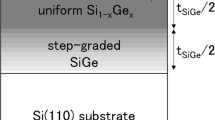Abstract
The strain technology is an effective way to improve hole mobility and CMOS device performance. Tetragonal strain leading to hole mobility enhancement in strained Si (001) has been verified by two aspects of theories and experiments. In this paper, we aim to study rhombohedral strain effect on the hole mobility of Si, which results from growing on the (111) oriented relaxed Si1−x Ge x substrate. It is found that structure transformation of Si from cubic to trigonal system occurs under the biaxial tensile stress imposed by the (111) substrate and that its corresponding averaged hole mobility increases about one time at most in comparison with one of unstrained Si. The results can provide valuable reference to the understanding of the strained Si material physics and its design.
Similar content being viewed by others
References
Song J J, Zhang H M, Hu H Y, et al. Calculation of band structure in (101)-biaxially strained Si. Sci China Ser G-Phys Mech Astron, 2009, 52(4): 546–550
Olsen S H, Yan L, Aqaiby R, et al. Strained Si/SiGe MOS technology: Improving gate dielectric integrity. Microelectron Eng, 2009, 86(3): 218–223
Guillaume T, Mouis M. Calculations of hole mass in [110]-uniaxially strained silicon for the stress-engineering of p-MOS transistors. Solid State Electron, 2006, 50(4): 701–708
Song J J, Zhang H M, Hu H Y, et al. Determination of conduction band edge characteristics of strained Si/Si1−x Gex. Chin Phys, 2007, 16(12): 3827–3831
Paul D J. Si/SiGe heterostructures: From material and physics to devices and circuits. Semicond Sci Technol, 2004, 19(10): R75
Yang L F, Jeremy R W, Rechard C W W, et al. Si/SiGe heterostructure parameters for device simulations. Semicond Sci Technol, 2004, 19(10): 1174–1182
Song J J, Zhang H M, Dai X Y, et al. Band structure of strained Si/(111)Si1−x Gex: A first principles investigation. Acta Phys Sin, 2008, 57(9): 5918–5922
Song J J, Zhang H M, Hu H Y, et al. Calculation of band edge levels of strained Si/(111)Si1−x Gex. Chin J Semicond, 2010, 31(1): 012001
Song J J, Zhang H M, Dian X Y, et al. Dispersion relation model of valence band in strained Si. Acta Phys Sin, 2008, 57(11): 7228–7232
Song J J, Zhang H M, Hu H Y, et al. Valence band structure of strained Si/(111)Si1−x Gex. Sci China-Phys Mech Astron, 2010, 53(3): 454–457
Wang Z C. Thermodynamics and Statistical Physics. 3rd ed. Beijing: Defense Industry Press, 2003. 263–264
Author information
Authors and Affiliations
Corresponding author
Rights and permissions
About this article
Cite this article
Song, J., Zhang, H., Hu, H. et al. Hole mobility enhancement of Si by rhombohedral strain. Sci. China Phys. Mech. Astron. 55, 1399–1403 (2012). https://doi.org/10.1007/s11433-012-4755-0
Received:
Accepted:
Published:
Issue Date:
DOI: https://doi.org/10.1007/s11433-012-4755-0



